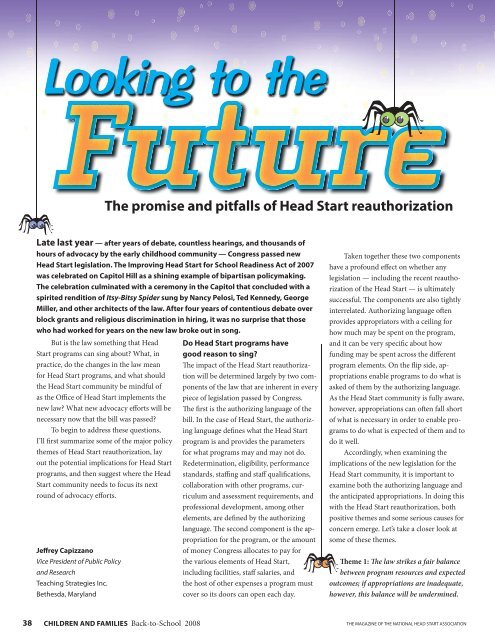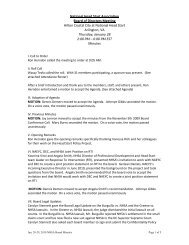New! - National Head Start Association
New! - National Head Start Association
New! - National Head Start Association
You also want an ePaper? Increase the reach of your titles
YUMPU automatically turns print PDFs into web optimized ePapers that Google loves.
Looking Looking Looking Looking Looking Looking Looking Looking Looking Looking Looking Looking Looking Looking Looking Looking Looking Looking Looking Looking Looking Looking Looking Looking Looking Looking Looking Looking Looking Looking Looking Looking Looking Looking Looking to to to to to to to to to to to to to to to to to to to to to to to to to to to to to to to to to to to the the the the the the the the the the the the the the the the the the the the the the the the the the the the the the the the the the the<br />
Je rey Capizzano<br />
Vice President of Public Policy<br />
and Research<br />
Teaching Strategies Inc.<br />
Bethesda, Maryland<br />
The promise and pitfalls of <strong>Head</strong> <strong>Start</strong> reauthorization<br />
Late last year — after years of debate, countless hearings, and thousands of<br />
hours of advocacy by the early childhood community — Congress passed new<br />
<strong>Head</strong> <strong>Start</strong> legislation. The Improving <strong>Head</strong> <strong>Start</strong> for School Readiness Act of 2007<br />
was celebrated on Capitol Hill as a shining example of bipartisan policymaking.<br />
The celebration culminated with a ceremony in the Capitol that concluded with a<br />
spirited rendition of Itsy-Bitsy Spider sung by Nancy Pelosi, Ted Kennedy, George<br />
Miller, and other architects of the law. After four years of contentious debate over<br />
block grants and religious discrimination in hiring, it was no surprise that those<br />
who had worked for years on the new law broke out in song.<br />
But is the law something that <strong>Head</strong><br />
<strong>Start</strong> programs can sing about? What, in<br />
practice, do the changes in the law mean<br />
for <strong>Head</strong> <strong>Start</strong> programs, and what should<br />
the <strong>Head</strong> <strong>Start</strong> community be mindful of<br />
as the O ce of <strong>Head</strong> <strong>Start</strong> implements the<br />
new law? What new advocacy e orts will be<br />
necessary now that the bill was passed?<br />
To begin to address these questions,<br />
I’ll rst summarize some of the major policy<br />
themes of <strong>Head</strong> <strong>Start</strong> reauthorization, lay<br />
out the potential implications for <strong>Head</strong> <strong>Start</strong><br />
programs, and then suggest where the <strong>Head</strong><br />
<strong>Start</strong> community needs to focus its next<br />
round of advocacy e orts.<br />
Do <strong>Head</strong> <strong>Start</strong> programs have<br />
good reason to sing?<br />
e impact of the <strong>Head</strong> <strong>Start</strong> reauthorization<br />
will be determined largely by two components<br />
of the law that are inherent in every<br />
piece of legislation passed by Congress.<br />
e rst is the authorizing language of the<br />
bill. In the case of <strong>Head</strong> <strong>Start</strong>, the authorizing<br />
language de nes what the <strong>Head</strong> <strong>Start</strong><br />
program is and provides the parameters<br />
for what programs may and may not do.<br />
Redetermination, eligibility, performance<br />
standards, sta ng and sta quali cations,<br />
collaboration with other programs, curriculum<br />
and assessment requirements, and<br />
professional development, among other<br />
elements, are de ned by the authorizing<br />
language. e second component is the appropriation<br />
for the program, or the amount<br />
of money Congress allocates to pay for<br />
the various elements of <strong>Head</strong> <strong>Start</strong>,<br />
including facilities, sta salaries, and<br />
the host of other expenses a program must<br />
cover so its doors can open each day.<br />
Taken together these two components<br />
have a profound e ect on whether any<br />
legislation — including the recent reauthorization<br />
of the <strong>Head</strong> <strong>Start</strong> — is ultimately<br />
successful. e components are also tightly<br />
interrelated. Authorizing language o en<br />
provides appropriators with a ceiling for<br />
how much may be spent on the program,<br />
and it can be very speci c about how<br />
funding may be spent across the di erent<br />
program elements. On the ip side, appropriations<br />
enable programs to do what is<br />
asked of them by the authorizing language.<br />
As the <strong>Head</strong> <strong>Start</strong> community is fully aware,<br />
however, appropriations can o en fall short<br />
of what is necessary in order to enable programs<br />
to do what is expected of them and to<br />
do it well.<br />
Accordingly, when examining the<br />
implications of the new legislation for the<br />
<strong>Head</strong> <strong>Start</strong> community, it is important to<br />
examine both the authorizing language and<br />
the anticipated appropriations. In doing this<br />
with the <strong>Head</strong> <strong>Start</strong> reauthorization, both<br />
positive themes and some serious causes for<br />
concern emerge. Let’s take a closer look at<br />
some of these themes.<br />
eme 1: e law strikes a fair balance<br />
between program resources and expected<br />
outcomes; if appropriations are inadequate,<br />
however, this balance will be undermined.<br />
38 CHILDREN AND FAMILIES Back-to-School 2008<br />
THE MAGAZINE OF THE NATIONAL HEAD START ASSOCIATION




